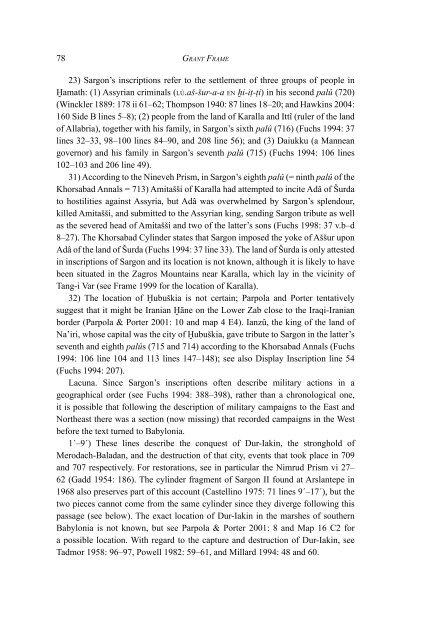Of GOd(s), Trees, KinGs, and schOlars - University College London
Of GOd(s), Trees, KinGs, and schOlars - University College London
Of GOd(s), Trees, KinGs, and schOlars - University College London
- TAGS
- kings
- scholars
- www.ucl.ac.uk
Create successful ePaper yourself
Turn your PDF publications into a flip-book with our unique Google optimized e-Paper software.
78 Gr a n t Fr a m e<br />
23) Sargon’s inscriptions refer to the settlement of three groups of people in<br />
Ḫamath: (1) Assyrian criminals (l ú.aš-šur-a-a e n ḫi-iṭ-ṭi) in his second palû (720)<br />
(Winckler 1889: 178 ii 61–62; Thompson 1940: 87 lines 18–20; <strong>and</strong> Hawkins 2004:<br />
160 Side B lines 5–8); (2) people from the l<strong>and</strong> of Karalla <strong>and</strong> Ittî (ruler of the l<strong>and</strong><br />
of Allabria), together with his family, in Sargon’s sixth palû (716) (Fuchs 1994: 37<br />
lines 32–33, 98–100 lines 84–90, <strong>and</strong> 208 line 56); <strong>and</strong> (3) Daiukku (a Mannean<br />
governor) <strong>and</strong> his family in Sargon’s seventh palû (715) (Fuchs 1994: 106 lines<br />
102–103 <strong>and</strong> 206 line 49).<br />
31) According to the Nineveh Prism, in Sargon’s eighth palû (= ninth palû of the<br />
Khorsabad Annals = 713) Amitašši of Karalla had attempted to incite Adâ of Šurda<br />
to hostilities against Assyria, but Adâ was overwhelmed by Sargon’s splendour,<br />
killed Amitašši, <strong>and</strong> submitted to the Assyrian king, sending Sargon tribute as well<br />
as the severed head of Amitašši <strong>and</strong> two of the latter’s sons (Fuchs 1998: 37 v.b–d<br />
8–27). The Khorsabad Cylinder states that Sargon imposed the yoke of Aššur upon<br />
Adâ of the l<strong>and</strong> of Šurda (Fuchs 1994: 37 line 33). The l<strong>and</strong> of Šurda is only attested<br />
in inscriptions of Sargon <strong>and</strong> its location is not known, although it is likely to have<br />
been situated in the Zagros Mountains near Karalla, which lay in the vicinity of<br />
Tang-i Var (see Frame 1999 for the location of Karalla).<br />
32) The location of Ḫubuškia is not certain; Parpola <strong>and</strong> Porter tentatively<br />
suggest that it might be Iranian Ḫāne on the Lower Zab close to the Iraqi-Iranian<br />
border (Parpola & Porter 2001: 10 <strong>and</strong> map 4 E4). Ianzû, the king of the l<strong>and</strong> of<br />
Na’iri, whose capital was the city of Ḫubuškia, gave tribute to Sargon in the latter’s<br />
seventh <strong>and</strong> eighth palûs (715 <strong>and</strong> 714) according to the Khorsabad Annals (Fuchs<br />
1994: 106 line 104 <strong>and</strong> 113 lines 147–148); see also Display Inscription line 54<br />
(Fuchs 1994: 207).<br />
Lacuna. Since Sargon’s inscriptions often describe military actions in a<br />
geographical order (see Fuchs 1994: 388–398), rather than a chronological one,<br />
it is possible that following the description of military campaigns to the East <strong>and</strong><br />
Northeast there was a section (now missing) that recorded campaigns in the West<br />
before the text turned to Babylonia.<br />
1´–9´) These lines describe the conquest of Dur-Iakin, the stronghold of<br />
Merodach-Baladan, <strong>and</strong> the destruction of that city, events that took place in 709<br />
<strong>and</strong> 707 respectively. For restorations, see in particular the Nimrud Prism vi 27–<br />
62 (Gadd 1954: 186). The cylinder fragment of Sargon II found at Arslantepe in<br />
1968 also preserves part of this account (Castellino 1975: 71 lines 9´–17´), but the<br />
two pieces cannot come from the same cylinder since they diverge following this<br />
passage (see below). The exact location of Dur-Iakin in the marshes of southern<br />
Babylonia is not known, but see Parpola & Porter 2001: 8 <strong>and</strong> Map 16 C2 for<br />
a possible location. With regard to the capture <strong>and</strong> destruction of Dur-Iakin, see<br />
Tadmor 1958: 96–97, Powell 1982: 59–61, <strong>and</strong> Millard 1994: 48 <strong>and</strong> 60.

















